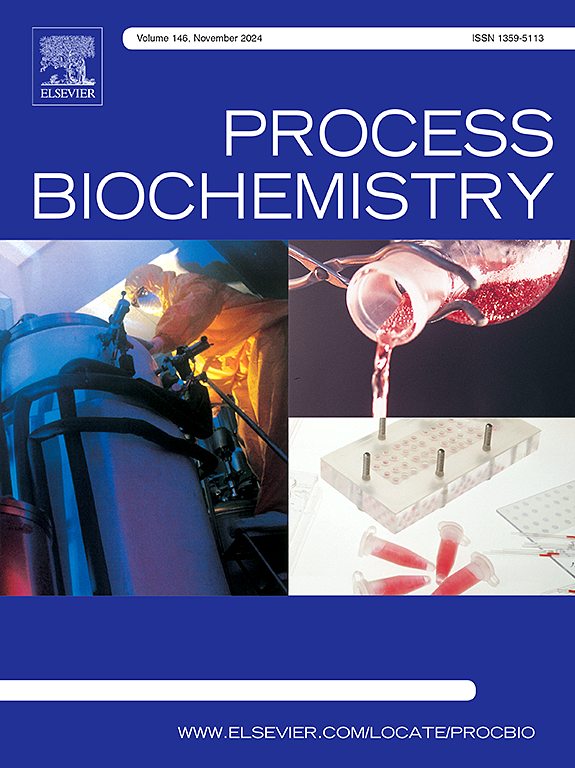揭示幽门螺杆菌检测:一种融合蛋白方法揭示了通过LIPS方法
IF 3.7
3区 生物学
Q2 BIOCHEMISTRY & MOLECULAR BIOLOGY
引用次数: 0
摘要
荧光素酶免疫沉淀系统(LIPS)方法是一种高灵敏度的定量检测抗体的方法,在确定病毒和细菌感染方面具有潜力。然而,荧光素酶-抗原融合蛋白体积庞大,给生产和折叠带来了挑战。使用表位而非全长抗原蛋白可以避免重组表达的问题。幽门螺旋杆菌是一种革兰氏阴性细菌,如果不加以治疗,有可能引发胃癌。这项研究的重点是生产一种融合蛋白,这种融合蛋白包含在硅学中设计的幽门螺杆菌尿素酶蛋白抗原表位和荧光素酶,目的是减小融合蛋白的体积并增强其在大肠杆菌系统中的表达。生物信息分析确定了编码抗原区域的序列,并通过聚合酶链反应(PCR)扩增了这些序列。然后设计了一个荧光素酶连接子-表位构建体,并在大肠杆菌 Bl21 (DE3) 菌株中表达。重组蛋白主要通过纯化达到均一,产生了一条 75 千道尔顿的主要条带。通过生物发光检测,证实了该蛋白的折叠和功能正常,其发射率为 13.7 × 10^6 RLU/s。Western 印迹分析证实了融合蛋白与幽门螺杆菌抗体的特异性结合。这些发现强调了该蛋白作为幽门螺杆菌检测候选蛋白的潜力,并简化了 LIPS 融合蛋白的生产。本文章由计算机程序翻译,如有差异,请以英文原文为准。
Shedding light on H. pylori detection: A fusion protein approach unveiled through LIPS method
The Luciferase Immunoprecipitation Systems (LIPS) method is a highly sensitive approach for quantitatively detecting antibodies, offering potential in identifying viral and bacterial infections. However, the substantial size of the luciferase-antigen fusion protein presents challenges in production and folding. Using epitopes rather than the full-length antigenic protein may circumvent issues with recombinant expression. Helicobacter pylori, a gram-negative bacterium, poses a risk of gastric cancer if untreated. This study focuses on producing a fusion protein comprising in silico-designed antigenic epitopes from the H. pylori urease protein and luciferase, aiming to reduce the fusion protein's size and augment its expression in the E. coli system. Bioinformatic analysis identified sequences encoding antigenic regions, which were amplified via PCR. A luciferase-linker-epitope construct was then devised and expressed in the E. coli Bl21 (DE3) strain. The recombinant protein was primarily purified to homogeneity, yielding a major band at 75 kilodaltons. Verification of the protein's proper folding and functionality was confirmed through a bioluminescence assay with an emission of 13.7 × 10^6 RLU/s. Western blot analysis authenticated the fusion protein's specific binding to H. pylori antibodies. These findings underscore the potential of the protein as a promising candidate for H. pylori detection and streamline LIPS fusion protein production.
求助全文
通过发布文献求助,成功后即可免费获取论文全文。
去求助
来源期刊

Process Biochemistry
生物-工程:化工
CiteScore
8.30
自引率
4.50%
发文量
374
审稿时长
53 days
期刊介绍:
Process Biochemistry is an application-orientated research journal devoted to reporting advances with originality and novelty, in the science and technology of the processes involving bioactive molecules and living organisms. These processes concern the production of useful metabolites or materials, or the removal of toxic compounds using tools and methods of current biology and engineering. Its main areas of interest include novel bioprocesses and enabling technologies (such as nanobiotechnology, tissue engineering, directed evolution, metabolic engineering, systems biology, and synthetic biology) applicable in food (nutraceutical), healthcare (medical, pharmaceutical, cosmetic), energy (biofuels), environmental, and biorefinery industries and their underlying biological and engineering principles.
 求助内容:
求助内容: 应助结果提醒方式:
应助结果提醒方式:


